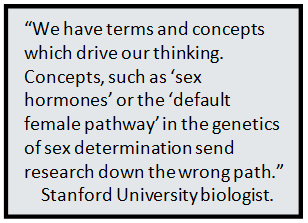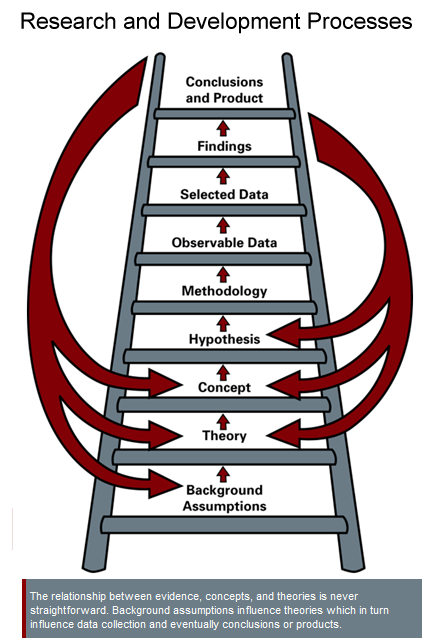 Theories provide a framework for explaining and predicting phenomena. Concepts relate to how data are described and interpreted, including how particular phenomena are categorized. Some theories concern a whole field and carry the status of a paradigm; others concern a few questions or topics within the field. In either case, theories and concepts frame how research is conducted within a particular field or topic area, influencing:
Theories provide a framework for explaining and predicting phenomena. Concepts relate to how data are described and interpreted, including how particular phenomena are categorized. Some theories concern a whole field and carry the status of a paradigm; others concern a few questions or topics within the field. In either case, theories and concepts frame how research is conducted within a particular field or topic area, influencing:
● what constitutes an interesting research topic
● what needs explanation (i.e., interesting research questions)
● what counts as evidence
● how evidence is interpreted (including concepts used)
● what methods are considered appropriate
The point of rethinking central concepts and theories in relation to sex and gender is to ensure:
1. that any assumptions made or issues addressed are based on the best available evidence and information,
2. and that the concepts and theories adopted do not blind researchers to important aspects of sex and gender that could be a fertile source for innovation.
Questions:
1. What (if any) “background assumptions” about sex and gender are shaping or embedded in the concepts and theories of the field? These may not be explicit. Background assumptions are shared preconceptions and practices within a research community that go unquestioned (Longino, 2002). Analyzing Gender and Analyzing Language and Visual Representations may help to uncover unconscious assumptions that inform concepts and theories.
2. What are the implications of concepts and theories about sex and gender for how research is conducted in the field—that is, the choice of research topics, the methods used, what counts as evidence, and how it is interpreted? How do these concepts and theories contribute to Formulating Research Questions? Do researchers assume that sex and gender are fixed and binary (see Analyzing Sex and Analyzing Sex in Hermaphroditic Species ? Do researchers assume that sex and gender are separate or do they consider the ways sex and gender may interact (see Case Study: Chronic Pain).
3. What issues related to sex and gender are not being addressed, or are being misunderstood or misrepresented, as a result of how concepts and theories are framed in the field? For example, the concept of the “out-of-position driver” rules out certain people as part of the population that engineers design for (see Case Study: Inclusive Crash Test Dummies).
4. Are there conflicts between the assumptions being made about sex and gender (within existing concepts and theories in the field) and relevant available evidence and understandings about sex and gender? How do concepts and theories need to be reformulated to take this new evidence into account?
5. How do new concepts or theories bring to light new evidence?
6. Do these concepts and theories open up spaces for gendered innovations?
 Example of essential concept and theory change: Initially, archeologists designated only certain stone objects, such as finely articulated arrowheads, spears, hand axes, and the like, as “tools.” This categorization led theorists to see early human societies as sustained by big-game hunting. In a second step, it was presumed (drawing on contemporary norms) that men were the toolmakers and hunters. When the concept of “tools” was opened up to include flake stone tools used in nutting, leatherworking, grain harvesting, and woodworking, theorists better understood the broad range of food production in early human societies. Expanding notions of what items count as “tools” in prehistoric societies opened new questions about what early people usually ate, and about the economic and cultural goals of tool-making societies (Conkey, 2007; Gero, 1993).
Example of essential concept and theory change: Initially, archeologists designated only certain stone objects, such as finely articulated arrowheads, spears, hand axes, and the like, as “tools.” This categorization led theorists to see early human societies as sustained by big-game hunting. In a second step, it was presumed (drawing on contemporary norms) that men were the toolmakers and hunters. When the concept of “tools” was opened up to include flake stone tools used in nutting, leatherworking, grain harvesting, and woodworking, theorists better understood the broad range of food production in early human societies. Expanding notions of what items count as “tools” in prehistoric societies opened new questions about what early people usually ate, and about the economic and cultural goals of tool-making societies (Conkey, 2007; Gero, 1993).
Example of essential concept change: Osteoporosis has traditionally been defined as a disease of white, postmenopausal women. Men, however, account for nearly a third of osteoporosis-related hip fractures in Europe and the U.S., and it is becoming clear that they have been underdiagnosed because of the limited scope of diagnostic definitions. Redefining osteoporosis to include men as well as at-risk minority groups has led to new research and clinical practices that address osteoporosis in broader populations (see Case Study: Osteoporosis). In contrast, heart disease has been defined as a disease of middle-aged men. Yet heart disease is also a major killer of women and gender-diverse people. Redefining heart disease to include these populations has required redefining heart disease symptoms and identifying new diagnostic tools; it will also require redefining populations used in clinical trials away from the traditional 70% men and 30% women and new research on the risks faced by transgender individuals (see Case Study: Heart Disease in Diverse Populations).
Works Cited
Conkey, M. (1993). Making the Connections: Feminist Theory and Archaeologies of Gender. In DuCros, H., & Smith, L. (Eds.), Women in Archaeology: A Feminist Critique, pp. 3-15. Canberra: Department of Prehistory Press at the Australian National University.
Gero, J. (1993). The Social World of Prehistoric Facts: Gender and Power in Paleoindian Research. In DuCros, H., & Smith, L. (Eds.), Women in Archaeology: A Feminist Critique, pp. 31-40. Canberra: Department of Prehistory Press at the Australian National University.
Gilbert, S. (2009). Developmental Biology, 8th Edition. Sunderland: Sinauer.
Lenhart, A., Kane, J., Middaugh, E., Macgill, A., Evans, C., & Vitak, J. (2008). Teens’ Gaming Experiences are Diverse and Include Significant Social Interaction and Civic Engagement. Washington, D.C. : Pew Internet and American Life Project.
Longino, H. (1990). Science as Social Knowledge. Princeton: Princeton University Press.
Uhlenhaut, N., Jakob, S., Anlag, K., Eisenberger, T., Sekido, R., Kress, J., Treier, A., Klugmann, C., Klasen, C., Holter, N., Riethmacher, D., Schütz, G., Cooney, A., Lovell-Badge, R., & Treier, M. (2009). Somatic Sex Reprogramming of Adult Ovaries to Testes by FOXL2 Ablation. Cell, 139 (6), 1130-1142





